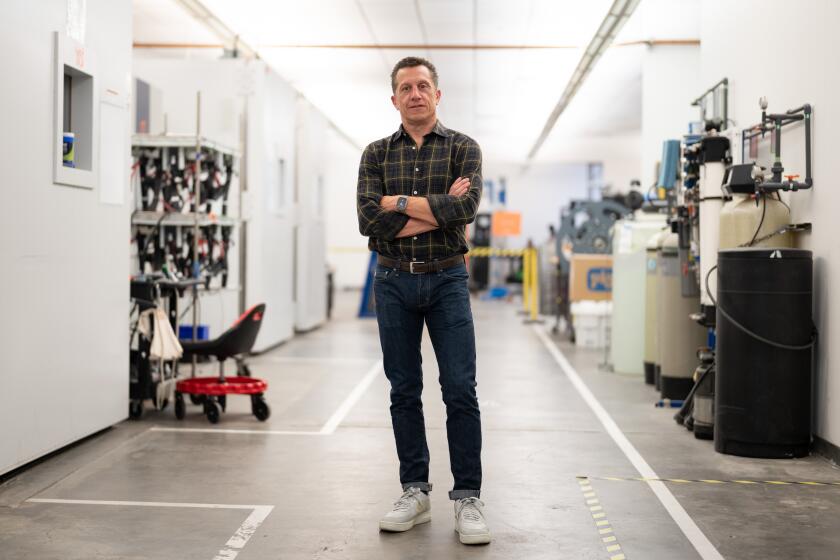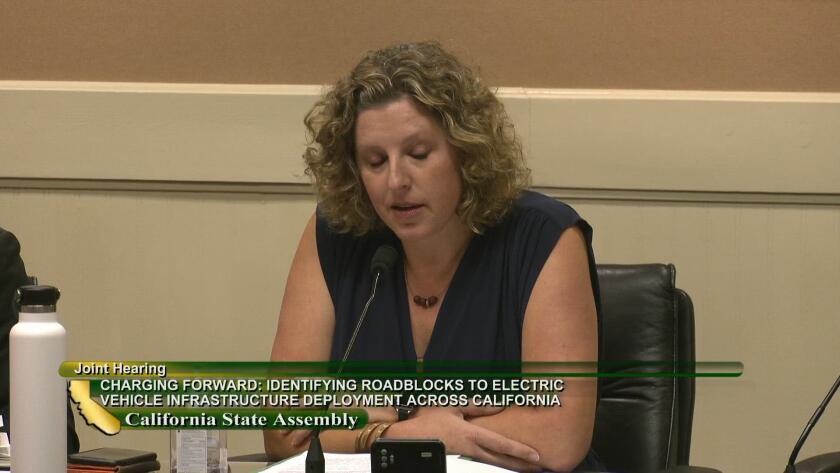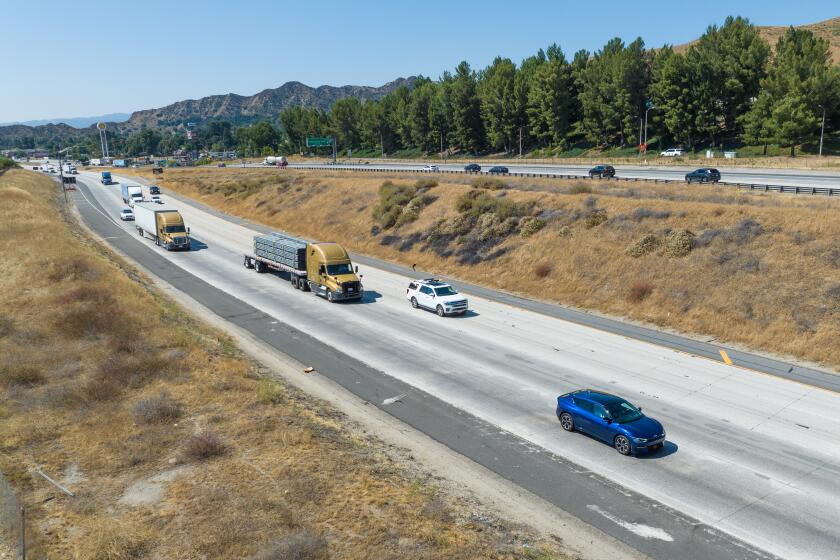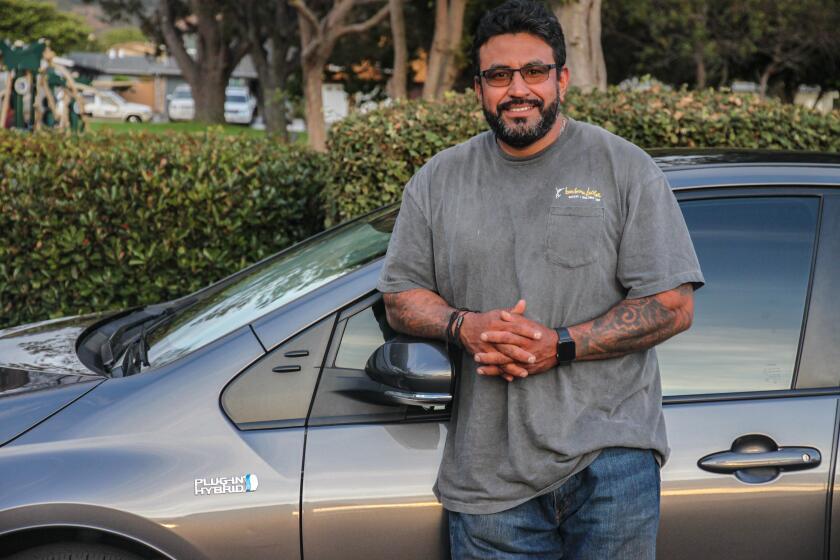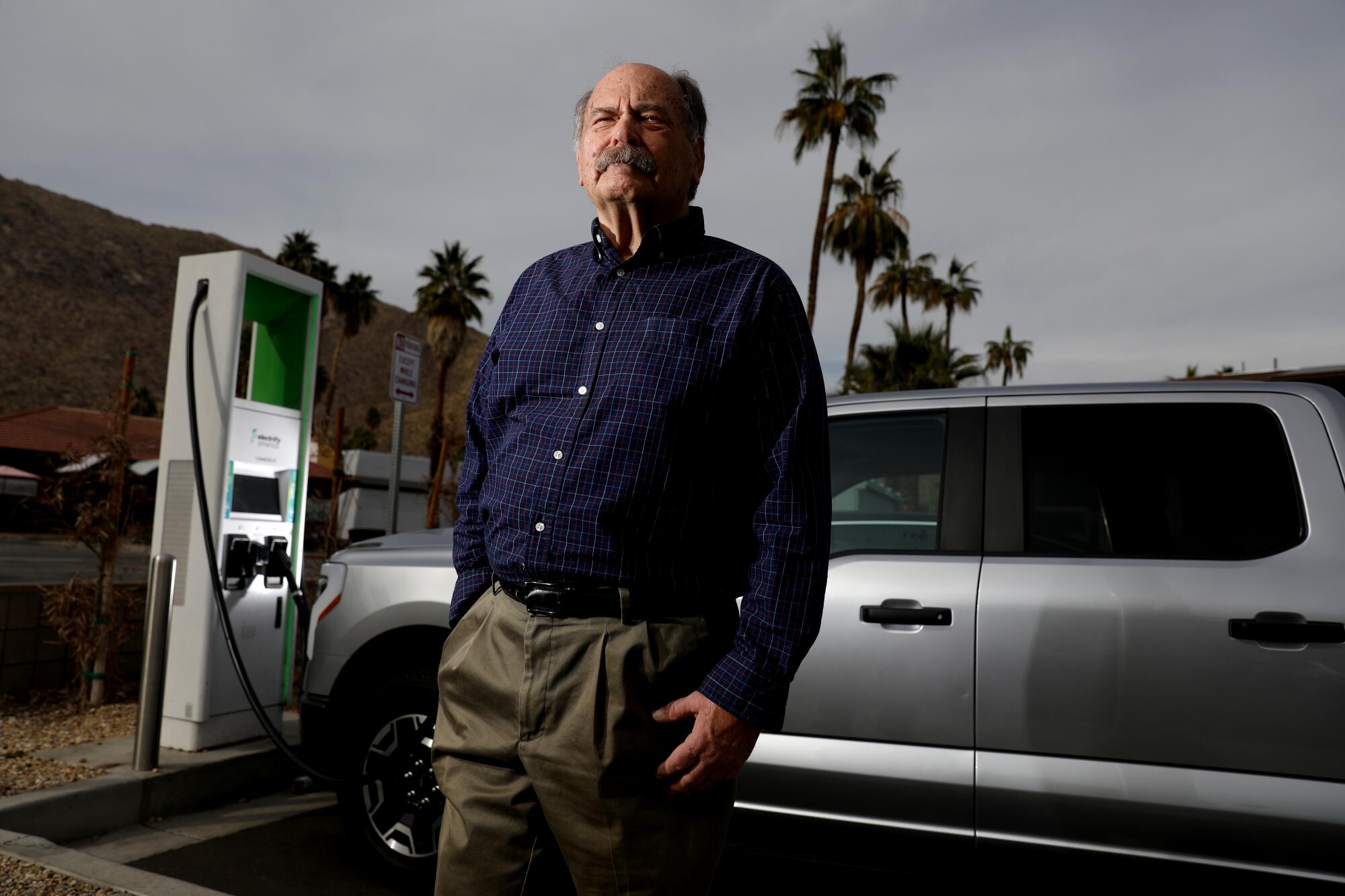
- Share via
Doug McCune of Oakland was set to buy an electric car, a Mustang Mach-E. The paperwork was complete; he only needed to sign. Still, he’d heard bad things about the EV public charging system, and felt nervous.
He borrowed a Mach-E from Ford, tried a few charging stations, then changed his mind.
“I couldn’t count on finding a charger that’s functional or that doesn’t have a line of cars waiting because only one of four chargers is working,” McCune said. “If I was comfortable with the charger situation, I would have bought the Mach-E.” He chose a Volvo plug-in hybrid instead.
He’s far from the only one worried about the dependability of the state’s charging system. Ask around and many EV owners will agree, public chargers have a bad reputation. Those operated by companies including ChargePoint, Electrify America, Blink and EVgo don’t work 20% to 30% of the time, according to studies from UC Berkeley and data firm J.D. Power.
How did the state-subsidized public charger system end up so problematic? California’s policies are at least partly to blame. The state chose not to require that charger companies meet performance standards as it doled out $1 billion in subsidies, grants and other assistance to charger companies, with billions more on the way.
“We were just trying to get chargers out there and learning,” said Patty Monahan, one of five commissioners on the California Energy Commission.
Aggressive and impactful reporting on climate change, the environment, health and science.
So no financial penalties for poor reliability were included in its subsidy and grant contracts, and no mechanisms for enforcement were set up.
In 2020, Gov. Gavin Newsom ordered that new cars and light trucks sold in California must be greenhouse-gas-free in increasing numbers until 2028, when more than half must fit that category, and 2035, when 100% of new cars and light trucks sold must be “zero emission.” More than a million and a half EVs are on the road today in the state.
Politicians, EV drivers, automakers and California taxpayers wonder how California’s ambitious climate targets can be reached if public charging remains unpredictable.
“The lack of reliability of the EV infrastructure is going to affect the goals unless we get our act together,” said Democratic Assemblymember Jacqui Irwin of Thousand Oaks.
read more coverage
ChargePoint’s CEO made tens of millions of dollars on state subsidies, no profits and an unreliable charger system.
Strong advocates of electric vehicles, deeply committed to greenhouse gas reduction, are furious at the lax oversight.
“If we don’t fix this, none of our plans, regardless of how good they are, will come to pass because consumers won’t accept EVs without a reliable EV infrastructure,” said Frank Menchaca, president of sustainable mobility solutions at the Society of Automotive Engineers.
Poor oversight stems in part from the state’s scattered approach to EV infrastructure management, critics say. No agency is fully in charge. The energy commission plays a big role; it has issued $448 million in grants and subsidies so far. The California Air Resources Board oversees an $800-million court settlement with Volkswagen after the emissions cheating scandal. The California Public Utilities Commission, the California Department of Transportation, and the California Division of Measurement Standards are responsible for pieces of EV infrastructure.

Subscribers get exclusive access to this story
We’re offering L.A. Times subscribers special access to our best journalism. Thank you for your support.
Explore more Subscriber Exclusive content.
The absence of ultimate responsibility troubles automakers such as Kia. The Korean company has committed to EVs and basks in glowing reviews from the automotive media for its new EV6 and EV9 electric cars. But the company is afraid sales will be crimped because too many chargers don’t work.
“What we’ve learned is that the infrastructure is at the top of reasons for rejection of EVs,” said Steve Kosowski, manager of strategy at Kia America, which is based in Irvine. Leadership of California charger spending is too diffuse and should be held more accountable, he said. “There needs to be an individual who is going to be monitoring and assuring and making sure that the funds going into this” are spent effectively.
As EV sales grow, gas taxes will fall. That means less money for California road construction, maintenance and repairs.
Another big problem: A lack of comprehensive data. The energy commission “lacks sufficient data on EV charging reliability to assess the reliability of the state’s charging network,” according to a September 2023 report that its staff wrote.
The government can’t even agree how many chargers there are in California.
The federal government counts 43,481 public chargers in the state, only about 50% of California’s own tally, according to the report, though the state’s estimate “lacks precision.”
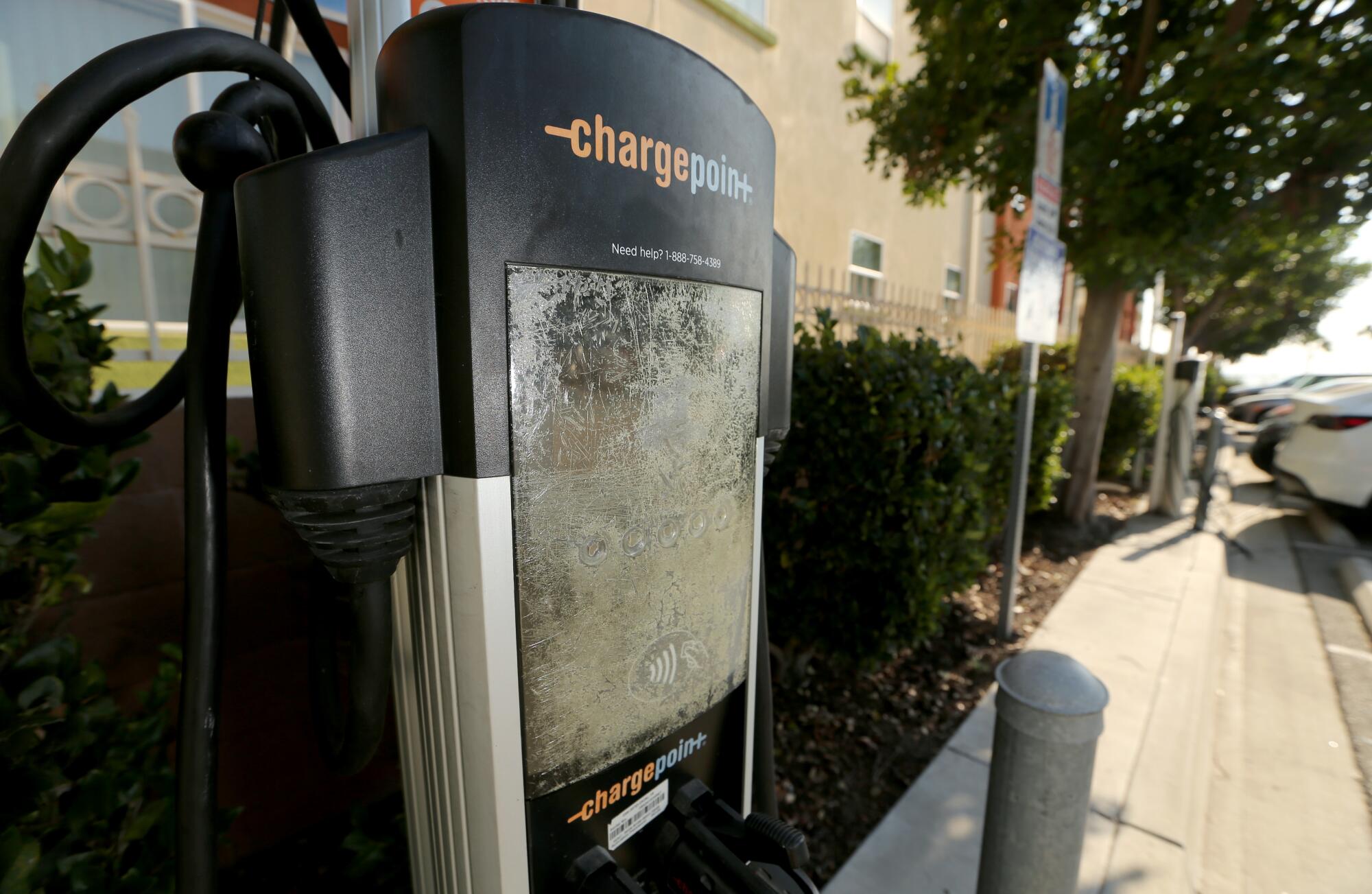
California aims to have 250,000 chargers installed by the end of next year, and a lot more government money is on the way.
Hundreds of millions of dollars are expected to be spent over the next several years. The federal government will pump $384 million into California — to be managed by the same agencies handling the state-funded charger program.
Automakers have invested heavily to build EVs and meet the California mandate, which has been adopted by a dozen other states committed to greenhouse gas reduction. Consulting firm AlixPartners said EV investment is expected to reach $616 billion in the five-year period of 2023-27, double the five-year figure for 2021-25.
- Share via
Assemblymember Pilar Schiavo recounts a miserable experience with public EV charging
Meanwhile, with EV owners flustered as automakers fret, charger company top executives are making bank. Pasquale Romano left his job last fall as chief executive at ChargePoint, the nation’s largest charger company measured by total installations. ChargePoint’s board paid him more than $31 million over the last three years, plus stock options that vest this month valued at $44.8 million.
Romano splurged on an $8.2-million home in Los Gatos, Calif., in September 2022 ($1,051 per square foot), reportedly the year’s priciest single-family home sale in that posh Silicon Valley enclave. It had a home theater, wine room, gym, art studio and library, according to the Compass real estate website. Also four bedrooms and seven full and half baths.
Buyers of new and used cars can soon make a down payment with free money from Uncle Sam — if they qualify.
Catherine Zoi quit her job as EVgo chief executive last fall too. Her compensation — more than $8 million — was less than Romano’s, but she’ll have more time to relax. “My husband and I have a ranch in Ojai, growing agave instead of citrus,” she said at a Q&A webinar in November. She’ll also advise young companies, she said.
Today, 17 years after the state’s public charger subsidies began, the energy commission continues to assess what kind of data it should collect on chargers. Legislative action was required in 2022 to force the commission to gather comprehensive charger data in the first place. The commission is still debating how to do that.
Why did it take so long to begin collecting data? The need became clear “as we saw the importance of having reliability and saw EV sales start to escalate,” said energy commissioner Monahan.
The commission started getting a bit tougher in late 2021, Monahan said, when it began including a 97% “uptime” requirement in new contracts. Uptime means the charger works when the customer needs it, and rules around calculating uptime allowing for weather, vandalism and other factors are being worked out.
Plug-in hybrid cars are an often overlooked alternative to full electric vehicles. But will they help the warming world? It’s controversial.
Monahan said the state will now physically inspect charger stations, through a contract with UC Davis.
The air resources board has a chance to get tougher with Electrify America at a meeting on Thursday, but appears ready to rubber-stamp the company’s plan to spend $200 million in settlement money with no mandates for working chargers and no financial penalties for nonperformance.
Some EV supporters are unhappy. “We feel it’s imperative at this point that all future funding has performance requirements and enforcement,” said Carleen Cullen of Cool the Earth, a San Francisco Bay Area organization dedicated to greenhouse gas reduction and EV adoption. “The industry needs to know they’re going to need to comply.”
Air resources officials declined to speak with The Times. However, at a meeting in June, the board’s chair, Liane Randolph, pleaded with the charger companies to get their act together. “Please make sure these chargers are fully maintained,” she said. “There is nothing more frustrating than planning on accessing a particular charging station and finding the units not working.”
The companies say they’re dedicated to fixing their charging networks. They blame — with some justification — supply chain problems, software bugs, vandalism and more. Both Electrify America and ChargePoint say they’re investing in operations centers, hiring more maintenance workers and installing new chargers that they hope will prove more dependable.
What about Tesla’s Supercharger network? By all reports, Tesla’s Superchargers, which to date have taken no state subsidy money, are working relatively well. But not everyone wants to buy a Tesla. “Tesla would have been the go-to car for us,” McCune said. But “Elon Musk’s antics” turned him off.
Distressed by the state of the public charger system, automobile companies have struck agreements with Tesla to use its Superchargers. The details are yet to be announced. No word on what percentage of Tesla chargers non-Tesla cars will be able to use, how much it will cost, or how Tesla will handle an influx of non-Tesla cars.
If it all works spectacularly well, Tesla could be on its way to a charger monopoly, or at least market dominance. In California, resale prices of electricity aren’t regulated. Charging stations aren’t required to erect conspicuous pricing signs like gas stations are.
A group of automakers is planning charger networks of its own, but is far behind Tesla: General Motors, Stellantis, Kia, Hyunai, Mercedes-Benz, BMW and Honda intend to spend $1 billion to build 30,000 public chargers in the U.S.
With all that’s gone down, has California learned lessons from its experience funding public chargers?
Cool the Earth’s Cullen said that because “a significant portion of the funds are for utility upgrades, securing land/sites, permitting et cetera,” the money spent isn’t a total waste. “The good news is that much of that investment still has significant value.”
The new CEO at ChargePoint, Rick Wilmer, who joined the company after running a salad-making machinery company, said he thinks the state’s investments are “money well spent.”
He added: “We are passionate about improving the transportation system for the health of the planet. Every initiative through every government entity that helps that happen is money well spent. We appreciate all the public entities.”

